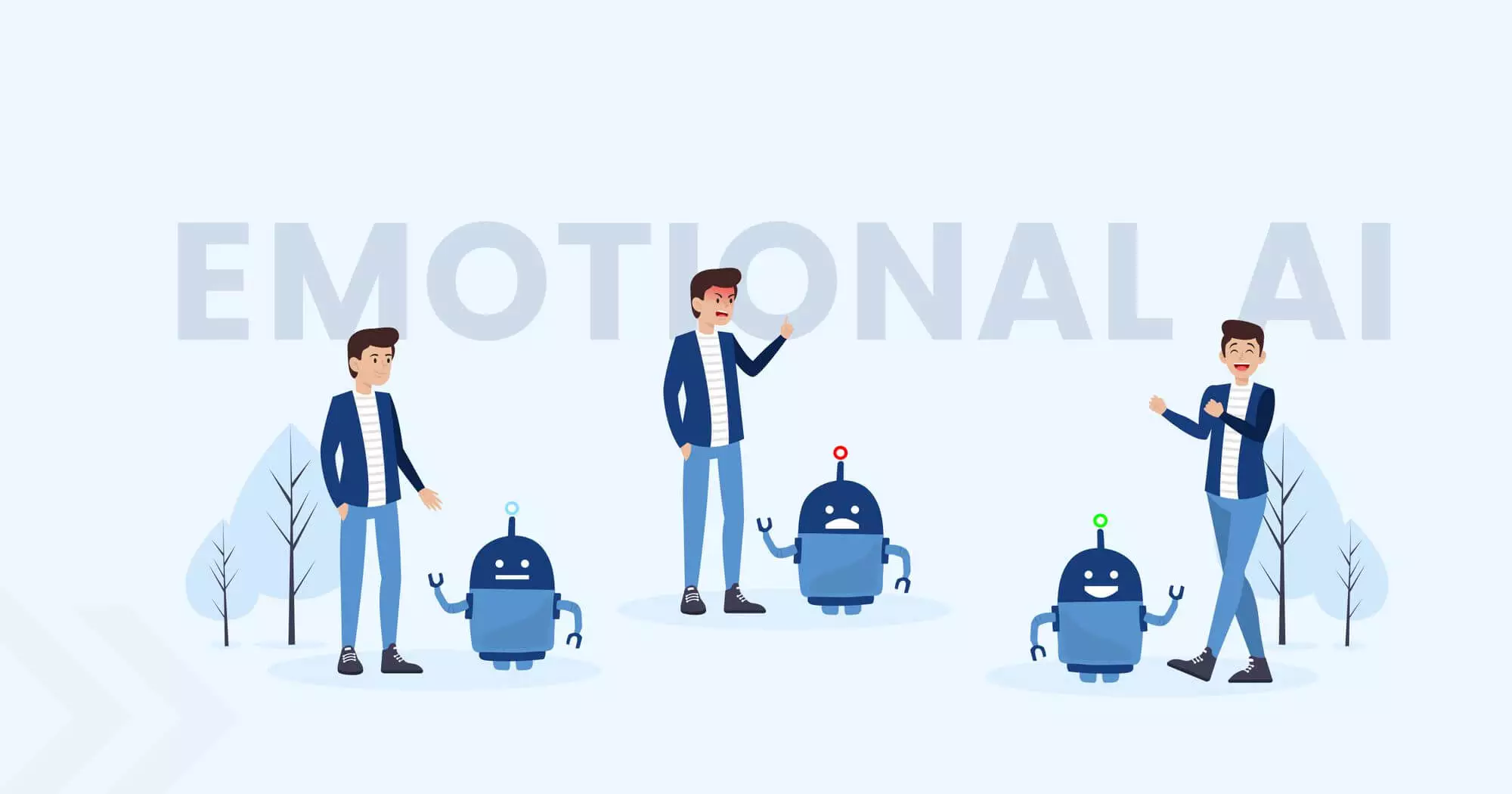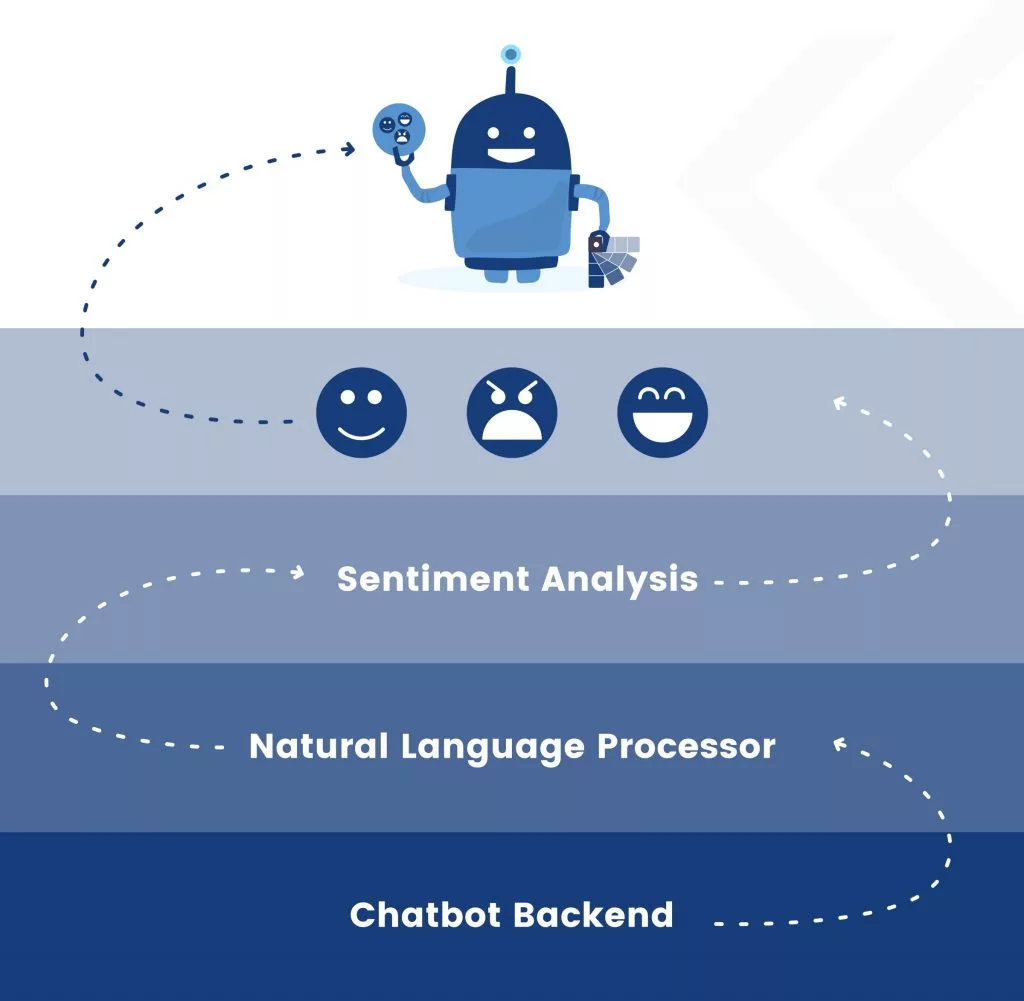Emotional AI : Empathy in chatbots

- November 12, 2020
- Priyanka Shah
- Conversational AI
While chatbots have been around for years, they’ve only surged to popularity recently with various industries making use of these virtual assistants to improve their customer service and interactivity. These AI softwares have proven to improve response scale, but the question now is
Are these bots as efficient as their human counterparts?
Only a few years ago, imagining a bot augment human like conversations would have seemed more or less like science fiction. However, the AI technology has rapidly grown to bridge this conversational chasm between robots and humans, and the emotionally intelligent AI is a reality today. A software capable of understanding, interpreting, replicating and reacting to human emotions is the latest development in the chatbot industry.
This new generation of bots are not just capable of communicating with their user but understand their emotions and acknowledge them in real time conversation. This advent of empathetic AI (also known as Emotional AI) stands to revolutionize customer experience and the use of bots for customer communications.
Before moving onto understanding how empathetic AI can be implemented to benefit your personal business requirements, it is paramount to understand what is empathy? And how it can be inculcated in your chatbot environment.
By definition, empathy is the ability to understand and share the feelings of another. Empathy itself can be categorised into – cognitive empathy, emotional empathy and compassionate (affective) empathy.
All three of these types basically coalesce into meaning –
Understanding the emotions and taking relevant actions to assist them. This intelligence can only be implemented by training your machine or in this case the chatbot.
This gives rise to the following questions:
1. How can chatbots implement this humane trait in order to create a compassionate conversational environment for its users? How can these robotic softwares be trained to imitate a human?
The answer to this question lies in the development and implementation of NLP (Natural Language Processing) models and Sentiment Analytics that are implemented within a chatbot to make it far more emotionally equipped to respond to users especially when it detects negativity. However, NLP models and Sentiment Analysis are two different terms that are often confused as one.
To put it broadly Natural Language Processing is understanding what has been expressed in natural human language and sentiment analysis can be termed as one of the most popular applications of natural language processing.
Natural Language Processing can be implemented using a custom model or by making use of popularly available NLP tools like the DialogFlow, wit.ai and Rasa NLU (Natural Language Understanding). Simply integrating these tools with your chatbot can improve your bot’s conversational user interface (CUI). A model that improves with time.
While NLP models are implemented to read and understand what has been said in natural language, sentiment analysis is done on this extracted information to generate value. NLP catalogs user information to generate response, and an analysis will compare user input with this data to determine user emotions.

Sentiment analysis basically recognises “how your user is feeling regarding something” it broadly categorises user response into positive and negative emotions. It is widely used in order to generate insights from the collection of textual data. This technique is implemented over a normal NLP model in order to extract sentiment from statements, and it makes use of the contextual information much like a human for understanding.
Consider the following two examples
I think my package is delayed, could I confirm if it will be delivered on time?
“My package is late again”.
While the first statement is reasonably neutral in it’s approach, the second statement reflects considerable disappointment. With a normal NLP implementation the response to both these statements could be something like “I am sorry for the inconvenience” however, this is not sufficient when looking to acknowledge your user.
The optimum response for the second statement should rather be, “That is quite disturbing, I understand your disappointment, let me look into this immediately.”
Now, this acknowledgement of user’s feelings can completely transform their experience and can go a long way in mitigating their negativity that they initially contacted you with. This is where empathy comes into play, to understand the depth of users’ emotions and accordingly reacting to it.
But the marketer in you will have one question – how will this actually make me more money? The ultimate goal of any industry small or large is to improve their sales and ensure high return on investment. To answer the marketer in you –
Maya Angelou once said – “I’ve learned that people will forget what you said, people will forget what you did, but people will never forget how you made them feel.”
Years later, this still holds true, even with chatbots that are being built specifically to communicate with humans. The direct benefits for your business through implementing Empathetic AI but not limited to are –
Benefits of Emotional AI:
Brand monitoring and building :
The applications of sentiment analysis and an emotionally intelligent bot service are not just limited to generating a relevant response. Empathy can inspire loyalty in your customers. When they feel understood, it builds their trust in the brand, increasing the longevity of their association with your organization.
Better customer support :
61% of organizations today are planning on incorporating chatbots into their customer experience, staying ahead of that kind of competition is going to require your customer support to be better than most – this is what an empathetic bot can do for you.
Market analysis :
The information gained through conversations can also be cashed to profit the overall productivity of your business. It can be leveraged to collect and validate user data and generate valuable insights regarding various aspects of a business. You could be learning from your user.
Customer sentiment tracking :
It can give you insights into what part of your services and products excite your user, where is your customer satisfaction dipping and much more. Industries are already making use of this technology to measure their user engagement and continually improve their user sentiment through engagement.
Business intelligence :
In the age of chatbots rapidly becoming the sole customer support agents it becomes necessary for businesses to consider their user’s reactions while making strategic decisions, it is how user return rate consistently improves. Remain ahead of the competition while generating insightful business strategies from user feedback.
At Kevit.io we are not only looking to improve your service with chatbot automation but also looking to connect this automation with real human emotion. A bot that not just communicates with your user but one that is emotionally intelligent to make your user experience one of its kind.
Mail us at coffee@kevit.io or visit Kevit.io to know more about Empathetic AI and how it can improve your market position, build your brand and much more.
See Kevit.io In Action
Automating business processes with Kevit.io is now just a click away!